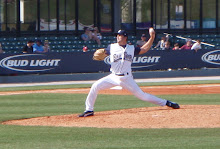
Aside from throwing strikes and getting hitters out, another one of a pitcher's most important responsibilities is controlling the running game. The better job a pitcher does of preventing runners from stealing bases, the easier job he will have preventing runs from scoring that otherwise would not. There are three basic ways to do this. You can attempt a pick off move to the base the runner is occupying, you can vary your looks (checking the runner with your eyes) and timing (how long you hold the baseball before delivering it to the plate) and finally, you can be quicker than normal delivering the pitch. Most pitchers utilize some variation of a shortened leg lift called a slide-step to allow them to get to the plate without allowing the runner to get a good jump toward the base they would be stealing.
The slide-step is especially important for right handed pitchers, because they do not have the benefit of looking at the runner on first as lefties do. They must rely on changing how long they hold the ball and then being quick to the plate to give their catcher to a chance to throw the runner out. Runners steal bases by studying a pitcher's movements. Unfortunately, most pitchers are creatures of habit and have a tendency to hold the ball almost exactly the same amount of time before delivering a pitch. If they check the runner at all, they usually check the exact same time and number of times. A good base stealer will pick up on these patterns and wait until the exact moment before he lifts his leg to the plate to break for the bag.
So...the "intelligent pitcher" must be aware of these tendencies and purposefully mix up how we address the hitter. It requires repetition and practice like anything else in pitching does to be comfortable when attempting to utilize these tactics.
Mechanically speaking, to use the slide step a few things have to change. These adjustments are minor, but imperative to allow a pitcher to still remain "athletic" throughout the delivery and throw downhill without the benefit of a high leg kick that is generally used out of the wind-up. Instead of a high kick, you must bring the front knee slightly up and back towards the back leg. The hands will mimic the minor movement of the front knee, moving slightly up and back. From this position, the pitcher must be especially quick when driving the front foot down and straight toward the target. At the same, the elbows must get to the loaded and parallel position that we see out of the wind up. Usually, the arm swing must be quicker and shorter than out of the wind up, because there is less time until the front foot hits ground. The pitcher must also make sure to allow the hip turn to provide the power in the delivery, once the elbows are at their highest point.
If the pitcher is able to execute these minor adjustments, then his velocity should not suffer at all while making his delivery to the plate about 1.2 to 1.5 seconds. If the catcher is able to throw down to seconds in or around 2.0 seconds, that gives the runner only 3.5 seconds to cover 80 feet (considering he's leading off). Most runners will not be able to do this and promptly be thrown out.
So there are the basics of controlling the running game. Let me know if you have any other questions about specific scenarios!!
Until Next Time!!

No comments:
Post a Comment